Training, Tagging, and Tokyo Temples: Starting Metadata Work
Spread over May 23rd (5) and June 4th (3). Current total hours: 8
On May 23rd, I had my first day and training for uploading metadata in Portal to Texas History. It was exciting to put all that I've learned in my coursework into practice. I was instructed on the intricacies of each piece of metadata they require me to input. These include main title, date, language, description (physical and content), subject key terms, coverage (date and place name), relation to specimens at the California Botanic Garden, and notes regarding what is written on the slide box or mount.
Through this training, I was able to upload a few records myself and they are visible to the public. While this collection does focus on plants, the group of photos I have been assigned are not necessarily botany related. Most of my photos are of architecture or animals while Carlquist spent time in Japan in the 1960's. This work is incredibly interesting as I am having to research what the buildings in the photographs are and try to determine small details from what I see.
On June 4th, I began my day working on photo metadata that I was initially trained on. I made corrections based on a supervisor's feedback and edited about twenty photograph records. Once I completed my first twenty records, I sent them over to supervisor for her to provide feedback. I am unable to upload metadata for other photos while I await her corrections.

This is the metadata editor we use. This is the platform I was trained on on May 23rd.

This is an image currently visible to the public that I uploaded the metadata for. It is available on the Portal to Texas History.

On the day of my training, I received my internship badge. This badge gives me access to different parts of the building.

These are the coin envelopes that contain prints and negatives. Not all envelopes contain both, many only have one negative to match the print on the front, some contain as many as ten of each.

This is a slide box that I wrote a transcription for. It says: Lepidium flavum Caulanthus inflax Brodiaea UCU's Kramer Hill.

These are negatives that I encapsulated. I wear nitrile gloves while working with the negatives so as not to damage them.
Reading Between the Slides: Encapsulation and Transcription
Spread over June 4th (3) and June 5th (5). Current total hours: 16
My second task on June 4th was to encapsulate photo negatives found in envelopes. These coin envelopes were an organization system he used to keep prints and negatives together. I documented whether or not the envelope had a print on the front, how many prints were inside, and how many negatives were inside. Then, I encapsulated the negatives in plastic, writing their unique identifier on the plastic. I placed all materials back in the envelope when completed. I enjoyed this activity as it was almost soothing. I love working with physical materials and I love doing the same task over and over. This type of work suits me.
On June 5th, I encapsulated more negatives in the same manner. I was then trained on transcribing handwriting from slide boxes. There are many interns on this team, but only myself and one other are able to do this task as it requires one to know how to read cursive. This task proved difficult as not only did Carlquist tend to write quickly and messily, he also is writing the scientific names of plants, which I am unfamiliar with. Luckily, I used the Specimen data from the Consortium of California Herbaria database to input what I was seeing and was able to interpret based on search results.
Scripts, Slides, and Python: Modern Tools for Archival Work
Spread over June 5th (1), June 6th (6), June 9th (4). Current total hours: 27
For the remainder of June 5th, I completed the handwriting transcription. On the morning of June 6th, I was trained on using Python to transcribe the handwriting on the envelopes that I have been working with. The information that I was tasked with pulling was the left, center, and right text, the scientific name, the collector number, and the date. These envelopes are all very uniform in what is written and where, which allows us to use AI to pull that information for us. This cannot be the case on the slide box I have been transcribing as they are not uniform in what they say or where he writes it. I was glad to work with Python as I am less comfortable with the digital aspects of the profession and know I need to learn. Our field is changing all the time and I need to learn all aspects.
At the end of the day on the 6th, I began work on slide rehousing. I pulled slides from their boxes and, using a table light to see, arranged them by likeness. I then numbered the slide mount depending on what box they came from and the order they were to go in. I placed them in their new archival box and put the slide box away for separate storage. I vastly enjoyed this activity as it dealt with handling physical materials.
On June 9th, I spent the day encapsulating negatives from the index envelopes. This is a task that is almost completed as there are only forty-three boxes to complete and I am on box thirty-eight. Each box has close to 200 envelopes.

More negatives I am encapsulating along with the spreadsheet used to log what is in the index envelopes. Most of the envelopes on this day contained two negatives and no prints, including on the outside

This is the information captured and uploaded through Python. I had to run the program and transfer it to the spreadsheet. Then, using formulas, fill in any gaps.

The workflow for transcribing index envelopes to Google Sheets using Python. This whole document is very helpful as the process is complicated.

The slides that I worked to rehouse. As Carlquist shot on film, most subjects have several photos that are practically identical. We organize them by likeness.
Metadata in Practice
June 11th (4) and June 12th (4): Remote work. Current total hours: 35
On June 11th, I received feedback on my first twenty images that I created metadata for. The main elements I needed to correct were title formatting, location keywords, and subject sections. I was able to make these corrections in about thirty minutes and sent it back for further corrections if necessary. I then worked on creating metadata for more photographs.
While valuable, this work is not what I prefer to do during my internship. Working solely on the computer is not what I like doing, but I know that this is a crucial part of the work done in archives in this digital age. I am getting practice in adhering to specific set of standards as outlined by the organization.
On June 12th, I continued uploading metadata for photographs. All the photographs I am uploading metadata for were shot by Carlquist, the botanist the archival project is focused on. My assigned photos are not focused on botany for the most part, unlike other slide boxes. These photographs are almost entirely taken in Japan and there are many that highlight traditional Japanese architecture at temples and shrines.

Working in Metadata Editor. This shows my preferred view of the platform, offering a thumbnail to preview what I will be working on.

This is a photograph of Shitennoji Temple in Osaka, Japan. It is a 35 mm, color positive, taken in July 1963 by Sherwin Carlquist.

This is what the metadata editor looks like when I successfully complete, make visible, and publish a record.

Inaccurate physical description is prefilled and I must change the size description of the photos I am working on.
Refining the Details: Learning Metadata and My Work Style
June 16th (4) and June 17th (4) Remote work. Current total hours: 43
On June 16th, I continued working through uploading metadata for my assigned images. I have hit a smooth workflow at this point, able to easily go through the process. Before, I was often needing to double (or triple) check that I was inputting the right things in the right spaces, but I am able to work quicker and with more confidence.
On June 17th, my work looked much the same: creating metadata for photographs taken by Carlquist. There are many sections that are prefilled, such as the collection name, etc. The physical description of the photo is also prefilled, though in my assigned photos the physical description is incorrect. Most of the photos for the collection are 4 x 4 cm and, therefore, that is what is prefilled in the section. I must change this part to represent the 35 mm photos I am describing.
I have been doing my internship remotely for the past couple of days as my husband is in the hospital after having surgery. This experience has shown me that I do not want to work a remote job. I find myself incredibly bored and I am much more motivated in a work dedicated space. Also, as I've mentioned previously, I much prefer to do physical tasks than digital.

I received an email from UNT declaring a network outage. This explained my suspicions as to why my metadata editor was down.

An example of a botany photograph I created metadata for. These images are very nice to work with as they are beautiful.
Unexpected Lessons: From Network Outages to Botanical Metadata
June 18th (4) and June 19th (4). Remote work. Current total hours: 51
June 18th started out a bit stressful. I am still working remotely while my husband recovers and as I am trying to begin working, the metadata editor is not functioning. I am continuing to refresh and reload, but nothing is changing. Finally, I start to question if UNT System is down as the metadata editor is through the Texas Portal to History through UNT. Sure enough, when I attempt to open Canvas, it is down. I then received an email from UNT declaring a network outage. Luckily, the portal was back up quickly and I was able to begin my work.
June 19th. I have been fortunate in that the photos I am creating metadata for are not botany focused. This means that there are less checks on relations and connections. I have been intimidated to start creating metadata for plant images. However, once I started I realized it is not as difficult as I thought it would be. The photographs are beautiful to look at as well which makes the work more fun.
Decoding Carlquist: Archival Organization and the Geography of Field Photography
June 23rd (4) and June 24th (4). Current total hours: 59
On June 23rd, I was pleased to return to the library and commence physical archival work. I was tasked with encapsulating negatives once again. The organization style of Carlquist pertaining to these envelopes is interesting. Some of the envelopes contain only one negative and no prints, some contain thirteen negatives and seven prints. It seems completely random. It is exciting because each envelope is a little surprise, you never know what you're going to get.
On June 24th, I was trained in a new task. I was to identify the location of the images based on the information written on the envelopes that was then transcribed using AI. As AI is not always able to accurate in transcribing handwriting, I had to work to interpret the locations based on a multitude of research methods. I used the site GeoNames to see if what I was interpreting was a real place. If I was unable to pick apart the letters, I went to the Specimen data from the Consortium of California Herbaria website. They are partnered with our research project and so I would look up the collecting event that the photograph was a part of to see where they identified the location to be. If I was unsuccessful in locating that collecting event, I would go through Carlquist's field notebooks, find the date written on the envelope, and see if he denoted the location in his notebook.
Once I had a solid idea of where the location was, I consulted our projects place name list to find how I was to format the location in the spreadsheet and locate any location keywords I could add to narrow the location down.
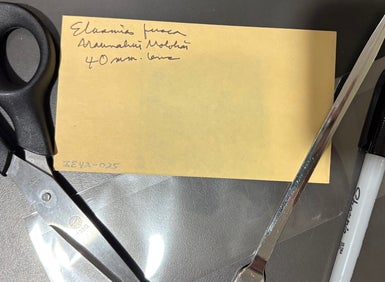
These are all the materials I need when encapsulating negatives. The envelopes containing the negatives, plastic archival sleeves, scissors to cut the sleeves to size, a letter opener to gently open the envelopes, and a thin Sharpie to write the negative's unique identifier on the archival sleeve.
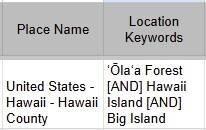
It is important that we include location keywords as well as the place name. People may search by colloquial terms and they should be able to access relevant materials when using those terms.
From Whale-Skate Island to Duke of Orleans Bay: Discoveries in the Archive
June 25th (4) and June 26th (4) Current total hours: 67
On June 25th, I spent some more time working on locations. I felt like I was learning a lot as many of the locations in this batch were different islands of Hawaii that I had never heard of. One interesting thing was seeing photos Carlquist had taken of Whale-Skate Island in the 1960's. This island washed away in the 1990's so these may be some of the last photos taken of the island.
I also spent time doing slide rehousing. This process is quite tedious and it requires me to really slow down and take my time. I enjoy doing it as I am able to put my hands on materials and see the original images.
On June 26th, the metadata editor was undergoing maintenance for most of my time in the office. Therefore, I worked on locations again. I find this work really interesting as he often used abbreviations or only named one word in the location title, so I have piece together what the location is based on context clues and research. There were two "eureka" moments as I was doing this work. One was simply labeled "D of O" and after a lot of research and combing through Carlquist's field notebook's I was able to determine this as Duke of Orleans Bay in Western Australia. The other moment can be found in the surrounding images.
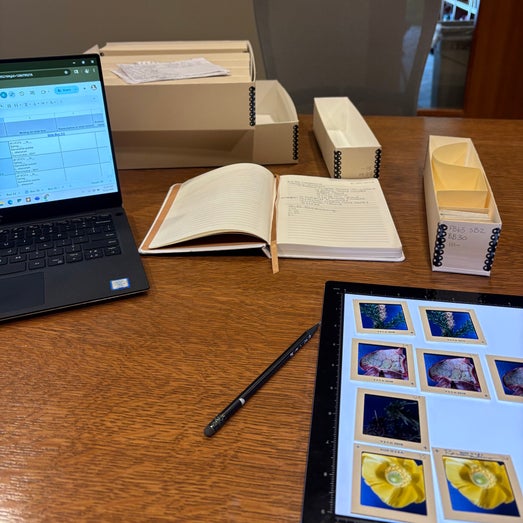
My slide rehousing workflow set up. I need the documentation spreadsheet, a lightboard to view the photo slides, a pencil to write numbers on the slides, a notebook to track my numbering, the "saltine boxes" the slides will be going into, and the flat boxes the "saltine boxes" go into. I use a notebook to note my numbering as it is vital to do accurate numbering. To mess up just one slides number would mean potentially needing to redo the entire box.
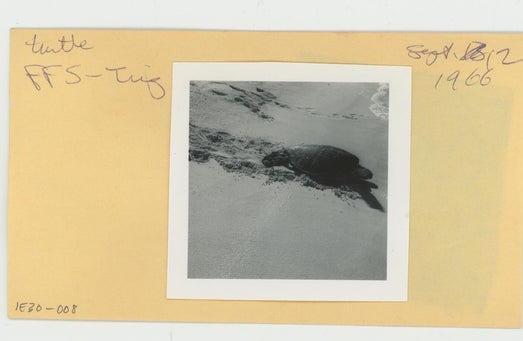
This is an example of the envelopes I was identifying locations for. This particular set was very interesting as I had to identify what "FFS-Trig" meant and I learned about the French Frigate Shoals which I never knew existed.
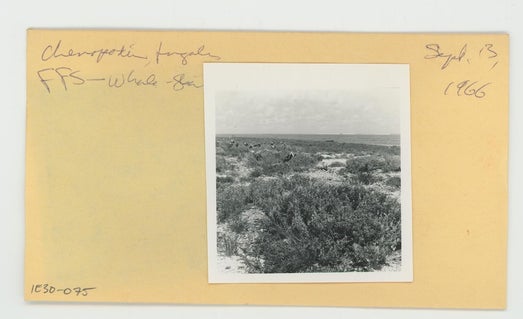
A photograph taken by Carlquist of White-Skate Island. This island has since been swept away and no longer exists.
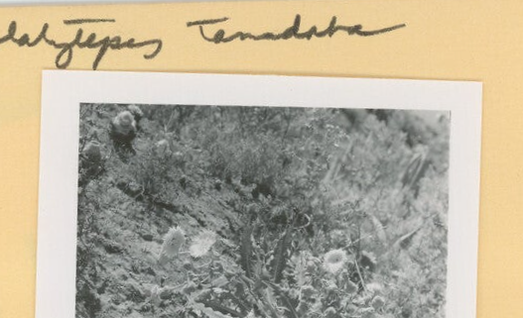
This blurry word in scrawling handwriting posed a great challenge for me. Through Googling many different letter combinations and narrowing the location down to either Spain or Portugal (based on other images in this part of the collection), I was able to determine it as Tamadaba Natural Park [AND] Parque Natural de Tamadaba. Finding these somewhat obscure locations is satisfying work!
Old Negatives, New Order
June 30th (4) and July 1st (4) Current Total Hours: 75
On June 30th, I started my morning slowly with continuing my work identifying locations for index envelopes. I was then trained on a new task that involved physical materials and a meticulous process. My favorite kind of work! I am able to work with my hands and I also have to really take my time and think about what I'm doing.
I was given a large box full of loose film housed in old Kodak paper envelopes. In each envelope, there are any number of negatives and their corresponding prints. From there, I encapsulated the negatives, recorded their new labels/names, both on a spreadsheet and on the encapsulation sleeve. Then, I encapsulated the prints. I placed all of these materials in a new envelope which I had labelled with its new identifier, the location, and the number of negatives found in the envelope.
It was very satisfying to watch the old, yellowed envelopes, edges crinkling and ripping and covered in scrawling handwriting, turn into crisp, clean envelopes with precise, uniform handwriting. All labels concise and in the same place, placed in a new archival box.
On July 1st, I continued working on the loose film rehousing for a few hours and then transitioned to identifying locations once again.
Before
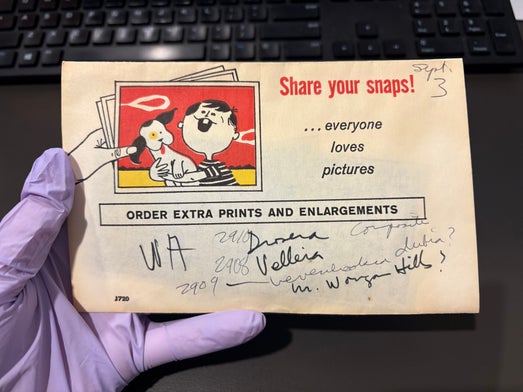
After
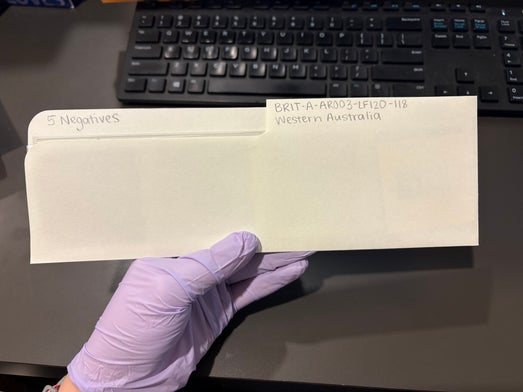
Before
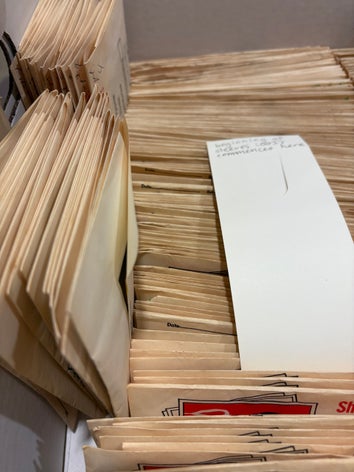
After
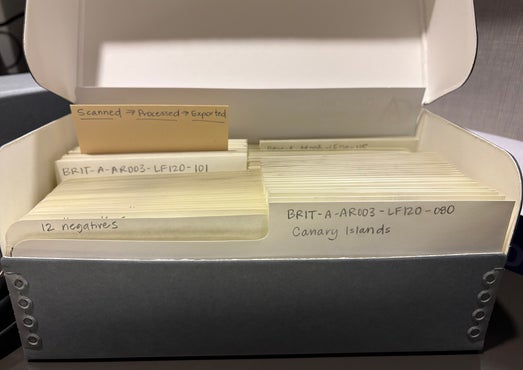
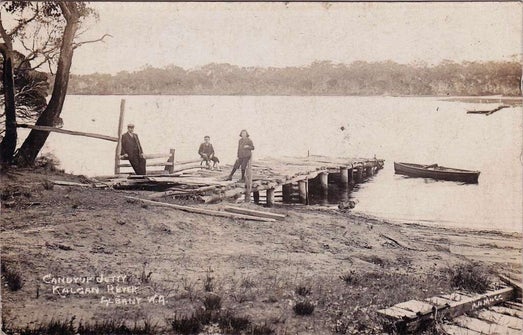
Old photo of the Kalgan River. Notice the note on the photograph that this is "Candyup Jetty". This photo is not part of our collection but something I found while researching the place.
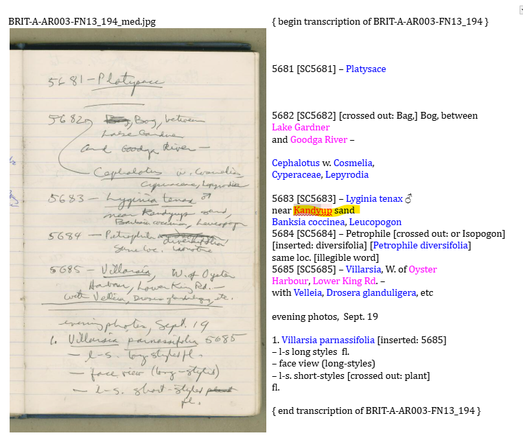
Transcription of Carlquist's field notes from the time he was in the area. Notice the misspelling of "Candyup" as "Kandyup". This helped me further my research that led to my interesting discovery.
Missing Links and Forgotten Names
July 2nd (4) and July 3rd (4) Current total hours: 83
On July 2nd I spent most of my shift in the glamourous world of spreadsheet maintenance. There were about 200 missing links from one page of our inventory spreadsheet and I went through and added rows, then added the appropriate links. This took a surprisingly long time, but it was necessary work that will benefit the project.
On July 3rd, I was led down a very interesting rabbit hole while completing my locations identification. On an envelope, Carlquist wrote "Kandiup" as the location, which I knew to be in Western Australia as that's where this part of the collection is from. I tried Googling this place and looking for it in GeoNames, but nothing came up. When I checked Carlquist's field notes from this time, I saw he spelled it, "Kandyup", indicating to me that he wasn't sure how to spell the name of the place. I started Googling different spelling variations until I came across Kalgan, which was formerly called Candyup. The name officially changed in the early 20th century, but it was still colloquially called Candyup for a while. My research found that it was informally called Candyup by residents until the 1950's. but this record of Carlquist's is from 1974. This shows that some people were still referring to this area as Candyup instead of the new name of Kalgan.
The Festival Note That Saved Me & The Envelope That Nearly Broke Me
July 7th (4) and July 8th (4) Current total hours: 91
On July 7th, I worked on location discovery for most of the morning. I then moved on to photo metadata. The photos I was creating metadata for largely involved the Aoi Matsuri Festival in Kyoto, Japan. One of my supervisor's asked me to include a brief description of the festival in a display note. Last week, I helped myself out and added that display note to each of the photo records that depicted the festival so I did not need to go back and find the description I had created. Today, all of these photos had the note and it helped save me time.
On July 8th, I had an interesting day. My locations envelopes usually only take me about an hour and a half to two hours, but it took me my entire four hour shift this day. There were 240 envelopes and nearly every two envelopes had a new location that I hadn't come across. Partner that with sloppy handwriting and Hawaiian spellings/ The most time consuming was "Kaumuohona", but it was the most interesting and most rewarding. I found that this location has been spelled differently on maps throughout it's history. This particular variation of the spelling is only found in entomology and these photographs were of insects. To find this location, I had to read two different articles, one of which was about the insect named on the envelope and the other was about how the name misspelling only apepars in entomology pursuits.
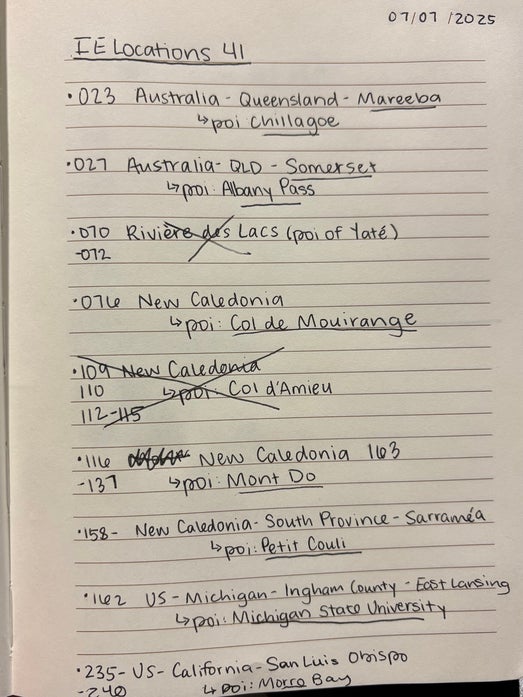
As I work on location discovery, I make notes on place names found on the materials that have not already been listed on our master place name list. P.O.I stands for "point of interest", meaning it's within a place that has an official name. The numbers indicate which envelope this place name is present on which makes it easier for me to add the names when they are uploaded to the master list. The marked out places are the ones I discovered were on the master list when I double checked.
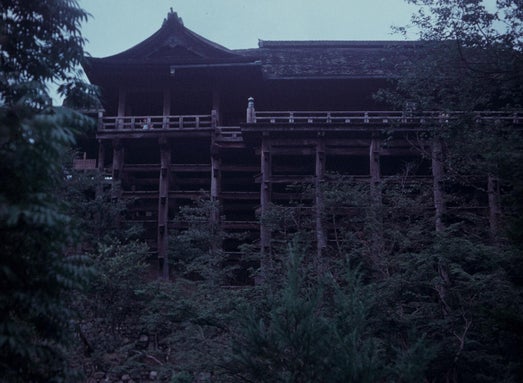
A photograph that I completed metadata for. This is demonstrates the magnitude of the veranda that is completely held together with interlocking wooden joints and no nails or screws.
The Metadata is Better When the Architecture is Beautiful
July 9th (4) and July 10th (4) Current total hours: 99
On July 9th, I spent nearly the whole shift on photo metadata. The photos I created metadata for were largely of temples in Japan. This architecture I visually stunning and it makes the work nicer.
Only July 10th, I spent half of my shift doing photo metadata once again. I discovered a photograph of the wooden veranda surrounding the Kiyomizu-dera Temple in Kyoto, Japan. This large, impressive structure was constructed without the use of a single nail. The style uses interlocking wooden joints. Working in archives, or really any information science profession, teaches you new things all of the time. I am finding that aspect of this internship particularly rewarding.
8,500 Envelopes Later: Lessons from the Archive
July 14th (4) and July 15th (4) Current total hours: 107
On July 14th, I completed more locations and helped with physical organization of some archival materials and office space. Going into the archival stacks, one of my supervisors and I identified where to file an article that Carlquist wrote in 1972.
I was also taught a new skill that I will be working on for the remainder of my practicum experience. Building a finding aid! I worked on the biographical note for Carlquist and learned a lot about his life through my research.
On July 15th, I completed our locations work for the index envelopes. There were forty-three total groups, each containing about 200-240 envelopes each. That's at least 8,500 envelopes to identify locations for! I am glad that I was able to make a contribution on this huge task and I enjoyed doing the work. I learned a lot of interesting facts along the way. I am strangely going to miss this task.
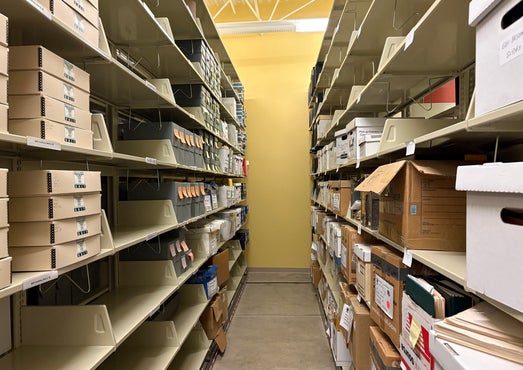
This is a photograph from the archive. There are many shelving units filled with materials. I have not spent much time in here, so when I am able to be in the stacks and I am amazed by the quantity of material.

This is a section of my supervisor's office. We worked together to clean up and organize the space. Many things were moved around as maintenance workers replaced the HVAC system, so cleaning was necessary.
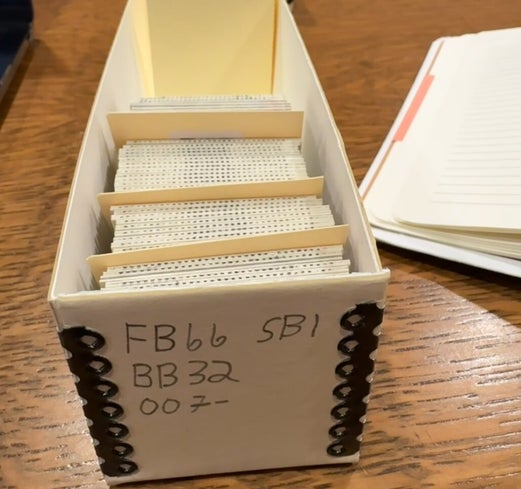
This is what the library calls a saltine box, this one is a work in progress as I complete slide rehousing. The boxes are long and skinny, resembling a packet of saltine crackers. That's where the name comes from.
Saltines, Slides, and Smooth Workdays
July 16th (remote: 4) and July 17th (4) Current total hours: 115
On July 16th, I worked from home due for health reasons. I spent the day working on photo metadata for Carlquist's 1963 and 1982 field expeditions to Japan, primarily Kyoto. I quickly got into a work rhythm and was able to complete quite a lot of photos. This set me on a good path to complete my saltine before the end of my internship experience.
On July 17th, I was back in the office and completed my assigned saltine box of photos to create metadata for. This was my second saltine to complete. Each saltine contains about 200 photos! Once I had completed this photo metadata assignment, I worked on slide rehousing.
Final Notes: Entomological Errors and Archival Endeavors
July 21st (5) Total hours: 120
On my final day, I had several tasks to complete. My supervisors asked that I write a blog post reflecting my time spent in this internship. I could pick a topic to focus on. I wrote about my experience discovering the misspelling of a place only done by entomologists. I finished writing the draft last week, so today I finished my final post, added visuals, and cited my sources. The marketing team will hopefully use it in their advertisements!
I also received feedback on my saltine box photo metadata. I worked to make those corrections and it took me roughly an hour. It is interesting to get my supervisors input on my metadata as I can see patterns in my language that may not be what they're looking for.
Finally, I ended my experience working on the finding aid for the collection. Specifically, I worked on inputting metadata into a spreadsheet regarding our index envelopes and then transferring that metadata to the inventory section of the finding aid. I was hesitant to do this task as it is very new to me, but I really enjoyed the learning process and am glad I have some experience with building finding aids now!
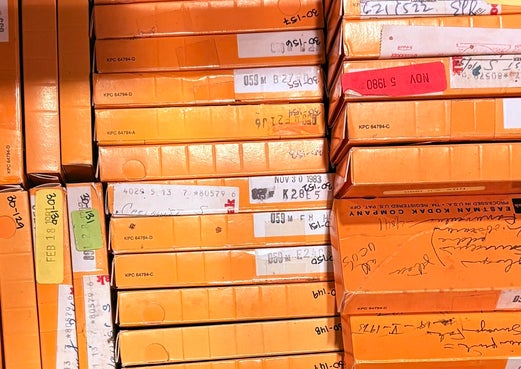
This is the way the photo slides were organized when given to the library. We take the slides out of each box, arrange them by likeness, and place them into saltine boxes.
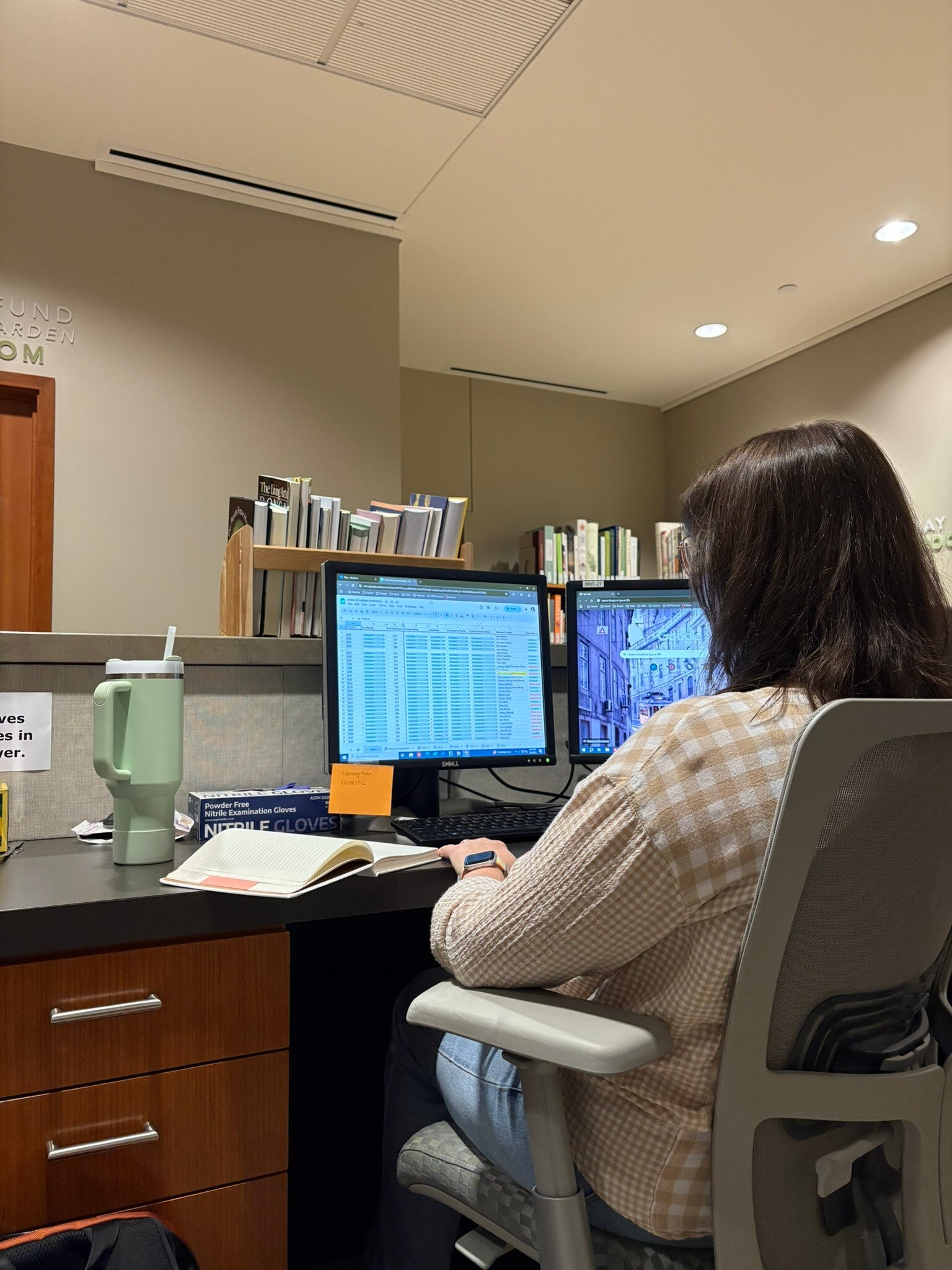
Practicum Experience Reflection
My internship this summer with BRIT Library was a wonderful experience. It really solidified for me that archival work is what I want to continue doing in my career. It was very fulfilling to see that all that I have learned in my coursework is applicable to the actual work I will be doing in archives. To be able to apply my knowledge was satisfying and validating. I am glad that I waited until the end of my graduate school experience to do this practicum as I was set up for success.
Though the tasks were quiet, I found most of them to be very fun. In particular, I enjoyed identifying the locations of the index envelopes. I learned so much through this task. It was always exciting to finally identify the place after searching through many different sources. I also strengthened my research skills through this task as I had to consider multiple avenues by which I could potentially find this information. I did not expect to learn the random tidbits about islands, architecture, etc. through this experience.
I have great admiration for the organization system that this archive has. While I was not here for the system set up and I'm sure it took many hours, the organizational flow makes a lot of sense and is easy to understand. The boxes are clearly labeled, photographs are clearly labeled, and so on. It is clear a lot of time and care went into setting up this system. Also, most information and logs are on the same spreadsheet, making the workflow less chaotic as most things are in the same place.
A position like this would be great for me to start my career with. It would allow me to further explore different elements of archival work while not throwing me in the deep ending of organizing a project like this. Through more low-level work I can gain experience and move up later in my career. I even reached out to my supervisors to ask if this role could become permanent. Unfortunately, funding is scarce and it is not a possibility. Disappointment aside, I know have a better understanding of what to look for in job postings.
Overall, I found this experience extremely beneficial, educational, and interesting. I learned a lot about the career I want to go into and this particular internship was the perfect fit for me. My supervisors were very thoughtful in the work they gave me, ensuring that I worked on a wide variety of tasks rather than only learning one or two skills. They were the ideal team to oversee this practicum experience and I am incredibly grateful for them.
Create Your Own Website With Webador